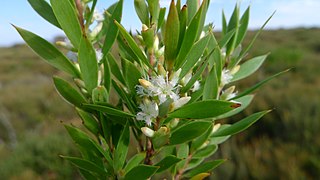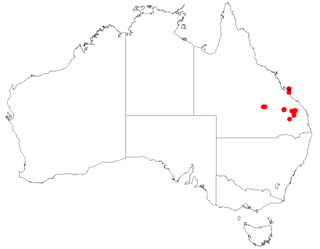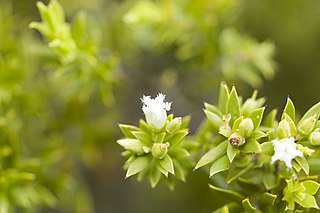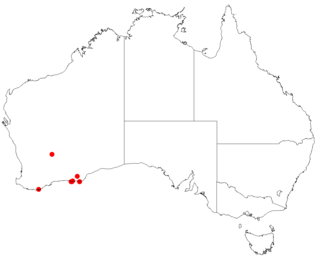
Styphelia sieberi, commonly known as prickly beard-heath, is a species of flowering plant in the heath family Ericaceae and is endemic to south-eastern continental Australia. It is an erect, densely-branched shrub with oblong to more or less egg-shaped leaves with the narrower end towards the base, and white, tube-shaped flowers arranged singly in upper leaf axils.

Styphelia setigera is a species of flowering plant in the heath family Ericaceae and is endemic to eastern New South Wales. It is an erect to spreading shrub with lance-shaped to elliptic leaves, and white, tube-shaped flowers arranged singly or in pairs in leaf axils, forming a spike 10–16 mm (0.39–0.63 in) long.

Leucopogon amplexicaulis, commonly known as beard-heath, is a species of flowering plant in the heath family Ericaceae and is endemic to eastern New South Wales. It is a scrambling or straggly shrub with egg-shaped, stem-clasping leaves with hairy edges, and spikes of small white flowers.

Styphelia esquamata, commonly known as the swamp beard-heath, is a species of flowering plant in the heath family Ericaceae and is endemic to south-eastern Australia. It is a slender shrub with mainly elliptic leaves, and short-lived white, tube-shaped flowers arranged singly or in pairs in upper leaf axils.

Styphelia pendula is a species of flowering plant in the heath family Ericaceae and is endemic to the south-west of Western Australia. It is an erect, straggling shrub with oblong leaves and white, tube-shaped flowers that are bearded inside.

Styphelia mutica, commonly known as blunt beard-heath, is a species of flowering plant in the heath family Ericaceae and is endemic to eastern Australia. It is an erect, straggling shrub with egg-shaped leaves with the narrower end towards the base, and small numbers of white, tube-shaped flowers that are densely bearded inside.

Styphelia acuminata is a species of flowering plant in the heath family Ericaceae and is endemic to the Northern Territory. It is a compact, erect shrub with narrowly elliptic or lance-shaped leaves and small groups of white or cream-coloured flowers.

Leucopogon alternifolius is a species of flowering plant in the heath family Ericaceae and is endemic to south of Western Australia. It is a low, sprawling shrub with thin branchlets, egg-shaped leaves with a heart-shaped, stem-clasping base, and white or pale pink flowers arranged in up to twenty groups along the flowering branchlets.

Leucopogon australis, commonly known as spiked beard-heath, is a species of flowering plant in the heath family Ericaceae and is endemic to southern Australia. It is an erect, aromatic shrub with narrowly egg-shaped to narrowly elliptic leaves, and white flowers arranged in spikes near the ends of branchlets.

Styphelia biflora is a species of flowering plant in the heath family Ericaceae and is endemic to eastern Australia. It is an erect to spreading shrub with hairy branchlets, oblong leaves and small white flowers.

Leucopogon collinus, commonly known as fringed beard-heath, is a species of flowering plant in the heath family Ericaceae and is endemic to south-eastern Australia. It is a slender, erect or spreading shrub with narrowly lance-shaped leaves, and white, tube-shaped, bearded flowers.

Styphelia cuspidata is a species of flowering plant in the family Ericaceae and is endemic to the central Queensland coast. It is a shrub with densely hairy young branchlets, egg-shaped to lance-shaped leaves with the narrower end towards the base, and white, bell-shaped flowers that are bearded inside.

Styphelia deformis is a species of flowering plant in the heath family Ericaceae and is endemic to eastern coastal Australia. It is a bushy shrub with narrowly egg-shaped leaves, and white, tube-shaped flowers.

Styphelia flexifolia is a species of flowering plant in the family Ericaceae and is endemic to south-east Queensland. It is a rigid shrub with many softly-hairy branchlets, crowded, sharply-pointed linear to lance-shaped leaves, and small, white, bell-shaped flowers that are bearded inside.

Styphelia leptospermoides is a species of flowering plant in the heath family Ericaceae and is endemic to eastern Australia. It is an erect, bushy shrub with elliptic to lance-shaped or oblong leaves, and white, tube-shaped flowers usually arranged singly in upper leaf axils.

Styphelia margarodes is a species of flowering plant in the heath family Ericaceae and is endemic to near-coastal areas of eastern Australia. It is an erect, spreading shrub with egg-shaped leaves with the narrower end towards the base, and small numbers of white, tube-shaped flowers usually arranged singly or in pairs in upper leaf axils.

Styphelia multiflora is a species of flowering plant in the family Ericaceae and is endemic to the southwest of Western Australia. It is a rigid shrub with crowded, sharply-pointed, linear to lance-shaped leaves, and white, tube-shaped flowers usually in groups in leaf axils.

Styphelia rotundifolia is a species of flowering plant in the heath family Ericaceae and is endemic to the south of Western Australia. It is an erect, bushy shrub with round or egg-shaped leaves, the narrower end towards the base, and white, tube-shaped flowers arranged in leaf axils in groups of 2 or 3.

Styphelia ruscifolia is a species of flowering plant in the heath family Ericaceae and is endemic to north Queensland. It is a shrub with oblong to broadly egg-shaped leaves, the narrower end towards the base, and white, tube-shaped flowers usually arranged singly or in pairs in leaf axils.
Styphelia compacta is a species of flowering plant in the heath family Ericaceae and is endemic to the south-west of Western Australia. It is a widely spreading or prostrate, much-branched shrub with egg-shaped leaves or lance-shaped leaves with the narrower end towards the base, and red flowers arranged in leaf axils.




















